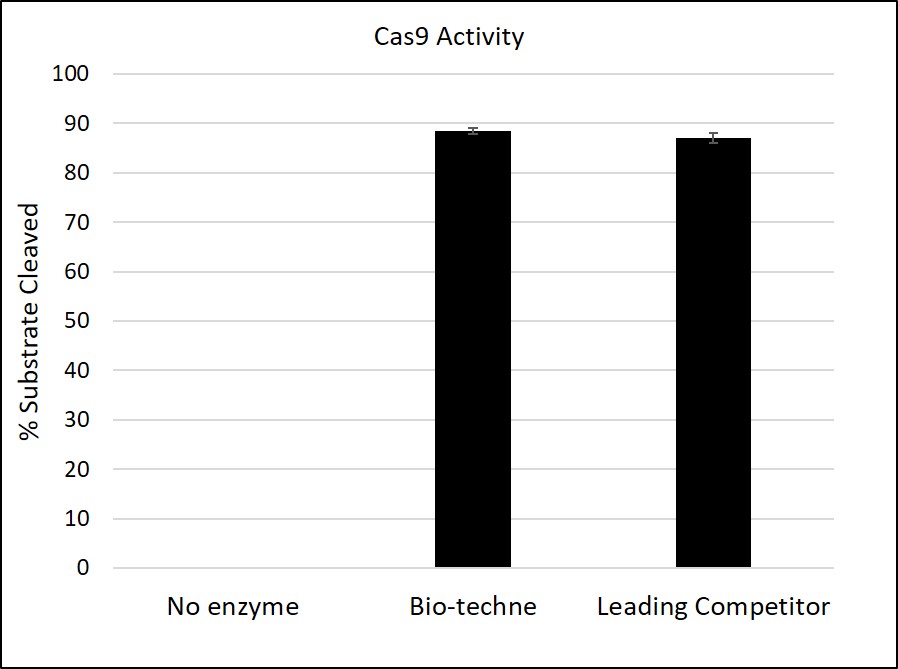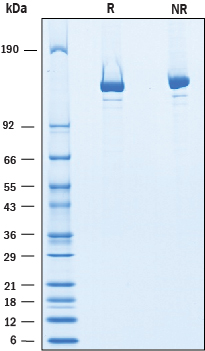Recombinant S. pyogenes CRISPR-associated Protein 9, CF
Recombinant S. pyogenes CRISPR-associated Protein 9, CF Summary
Product Specifications
| APKKKRKVGIHGVPAA | S. pyogenes CRISPR-Cas9 (Asp2-Asp1368) Accession # Q99ZW2 | KRPAATKKAGQAKK-KKGYGRKKRRQRRRG | HHHHHH |
| N-terminus | C-terminus | ||
Analysis
Product Datasheets
Carrier Free
CF stands for Carrier Free (CF). We typically add Bovine Serum Albumin (BSA) as a carrier protein to our recombinant proteins. Adding a carrier protein enhances protein stability, increases shelf-life, and allows the recombinant protein to be stored at a more dilute concentration. The carrier free version does not contain BSA.
In general, we advise purchasing the recombinant protein with BSA for use in cell or tissue culture, or as an ELISA standard. In contrast, the carrier free protein is recommended for applications, in which the presence of BSA could interfere.
9957-C9
| Formulation | Supplied as a 0.2 μm filtered solution in Tris, NaCl, EDTA, Glycerol and TCEP. |
| Shipping | The product is shipped with polar packs. Upon receipt, store it immediately at the temperature recommended below. |
| Stability & Storage: | Use a manual defrost freezer and avoid repeated freeze-thaw cycles.
|
Assay Procedure
- Assay Buffer: 50 mM NaCl, 10 mM Tris-HCl, 10 mM MgCl2, 100 µg/mL BSA, pH 7.9
- Recombinant Streptococcus pyogenes CRISPR-Cas9 (rS. pyogenes Cas9) (Catalog # 9957-C9)
- PBR322 vector (NEB, Catalog # N3033S) digested with EcoRI-HF (NEB, Catalog # R3101S)*
- Dharmacon synthetic sgRNA, targeting sequence: GAGGCAGACAAGGTATAGGG
- Ethidium Bromide, 10 mg/mL (Amresco, Catalog # X328)
- Ultrapure DNase/RNase-Free Distilled Water (Invitrogen, Catalog # 10977015), to prepare Assay Buffer
- DNA gel
*Digest was gel purified using gel purification kit and eluted in EB buffer (10 mM Tris-HCl, pH 8.5).
- Prepare RNP Complex:
a. 600 nM sgRNA (6 µL addition from 3 µM stock prepared in Assay Buffer)
b. 0.25 μg rS. pyogenes Cas9
c. Add Assay Buffer for a final RNP Complex volume of 26.5 µL
d. Incubate for 5 minutes at 37 °C. - Mix RNP Complex with 3.5 μL of 8.6 ng/µL of DNA Substrate (diluted in Assay Buffer, if possible).
- Incubate for 1 hour at 37 °C.
- Incubate for 10 minutes at 65 °C to dissociate enzyme from DNA.
- Load total reaction with loading dye on a 1% agarose gel.
- Run gel at 140 V for 40 minutes.
- Soak gel in 200 mL TAE with 150 μL of 10 mg/mL ethidium bromide for 1 hour.
- Use imaging software to detect and quantify hydrolysis of the DNA substrate.
- rS. pyogenes Cas9: 0.25 μg
- DNA Substrate: 30 ng
- sgRNA: 600 nM
Scientific Data
 View Larger
View Larger
Quantitative analysis of the substrate cleavage by densitometry of the agarose gel. Error bars display standard error of 3 replicates. 9957-C9 has equivalent activity to a Leading Competitor's Cas9 using the insert assay protocol.
 View Larger
View Larger
Agarose gel image of in vitro cleavage of DNA substrate into two DNA products by 9957-C9 and a Leading Competitor's Cas9.
 View Larger
View Larger
2 μg/lane of Recombinant S. pyogenes CRISPR-Cas9 was resolved with SDS-PAGE under reducing (R) and non-reducing (NR) conditions and visualized by Coomassie® Blue staining, showing a band at ~130 kDa.
Reconstitution Calculator
Background: CRISPR-Cas9
Streptococcus pyogenes Cas9 (CRISPR associated protein 9) is a 160 kDa RNA guided endonuclease that introduces site specific cleavage of double strand DNA (1). It is part of the Clustered Regularly Interspaced Short Palindromic Repeats (CRISPR) system found in many bacteria such as S. pyogenes and most archaea, which provide adaptive immunity against invading mobile genetic elements (such as viruses, transposable elements and conjugative plasmids) (2, 3). Upon viral infection, short viral DNA (known as "spacers") integrate into the host genome between CRISPR repeats, and RNA sequences (guide RNA or gRNA) with this genetic information help guide Cas9 protein to recognize and cut foreign DNA. Cas9 protein undergoes conformational changes upon gRNA binding that shift from non-DNA binding conformation into an active DNA binding conformation. In the Cas9-gRNA complex, the gRNA sequence remains accessible to interact with free DNA, and the extent to which the gRNA spacer and target DNA segment (known as "protospacer") match will determine the cut site (4). The presence of a 5′-NGG-3′ protospacer adjacent motif (PAM) sequence immediately downstream of protospacers is required for Cas9 cleavage of the foreign DNA. PAM is absent in bacterial CRISPR loci, therefore preventing cleavage of the host genome (4). Cas9 associates with other proteins of the acquisition machinery (Cas1, Cas2 and Csn2), presumably to provide PAM specificity to this process (5). This RNA guided nuclease system called CRISPR/Cas (CRISPR associated protein) has been widely applied to genome engineering with increased efficiency (6). The attached nuclear localization signals(NLSs) on the chimeric protein ensures nuclear compartmentalization in mammalian cells during gene editing (7).
- Feng, Z. et al. (2013) Cell 154:1380.
- Moineau. et al. (2010) Nature 468:67.
- Barrangou, R. et al. (2014) Molecular Cell 54:234.
- Charpentier, E. et al. (2011) Nature 471:602.
- Heler, R. et al. (2015) Nature 519:199.
- Thomson, J.A. et al. (2013) PNAS,110:15644.
- Cong, L. et al. (2013) Science 339:819.
FAQs
No product specific FAQs exist for this product, however you may
View all Proteins and Enzyme FAQsReviews for Recombinant S. pyogenes CRISPR-associated Protein 9, CF
There are currently no reviews for this product. Be the first to review Recombinant S. pyogenes CRISPR-associated Protein 9, CF and earn rewards!
Have you used Recombinant S. pyogenes CRISPR-associated Protein 9, CF?
Submit a review and receive an Amazon gift card.
$25/€18/£15/$25CAN/¥75 Yuan/¥1250 Yen for a review with an image
$10/€7/£6/$10 CAD/¥70 Yuan/¥1110 Yen for a review without an image
